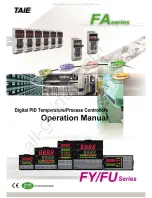
Controller functions
46
UPT-640 (as of SW 100)
9.25
System monitoring/alarm output
To increase operating safety and to avoid faulty heatse-
aling, the controller incorporates special hardware and
software features that facilitate selective fault detection
and diagnosis. Both the external wiring and the internal
system are monitored.
These features crucially support the system owner in
localizing the cause of an abnormal operating state.
A system fault is reported or differentiated by means of
the following elements.
A.)
Error message on the display:
The cause of a fault can be localized quickly and easily
with the help of the error code that appears on the dis-
play. Please refer to section 9.27 "Fault areas and
causes" on page 50 for a list of the possible error
codes.
B.)
Alarm relay (relay contact, terminals 5+6):
This contact is set in the factory as follows:
•
OPEN
if error code 104…106, 111…113 or 211 is
displayed. The contact closes, however, if a
"START" signal is activated in this state.
•
CLOSED
if error code 101…103, 107, 108,
201…203, 801 or 9xx appears.
If the alarm relay is configured differently from the fac-
tory setting (
section 8.3.11 "Configuration of the
alarm relay" on page 20), these states are inverted.
C.)
Error code output via the 0 to 10VDC
actual value output (terminals 20+24):
Since a temperature indication is no longer necessary
if a fault occurs, the actual value output is used to dis-
play error codes in the event of a fault.
13 voltage levels are offered for this purpose in the
0…10VDC range, each of which is assigned an error
code (
section 9.27 "Fault areas and causes" on
page 50).
If a state that requires AUTOCAL occurs – or if the con-
troller configuration is incorrect – (error codes
104…106, 111…113 or 211), the actual value output
jumps back and forth at 1Hz between the voltage value
that corresponds to this error and the end of the scale
(10VDC, i.e. 300°C or 500°C). If the "START" signal is
activated in one of these states, the voltage value does
not change any more.
Selective fault detection and indication can thus be
implemented simply and inexpensively using the
analog input of a PLC with a corresponding error mes-
sage (
section 9.27 "Fault areas and causes" on
page 50).
An error message can be reset by pressing
the "RESET" key, by activating the "RESET"
signal at terminals 20+26 (
section 9.10 ""RESET"
signal" on page 34) or by switching the controller
off and then on again.
Invalid error messages may appear when the
controller is switched off owing to the unde-
fined operating state. This must be taken into
account when they are evaluated by the higher-
level controller (e.g. a PLC) in order to avoid false
alarms.
9.26
Error messages
The table below shows how the analog voltage values
that appear at the actual value output correspond to the
faults that have occurred. It also describes each fault
and the required corrective action. The block diagram
in section 9.27 "Fault areas and causes" on page 50
permits each fault to be cleared quickly and efficiently
The error codes described below can also be displayed
in the ROPEX visualization software (
section 9.21
"Diagnostic interface/visualization software" on
page 38) to facilitate troubleshooting.
If the actual value output is evaluated in order
to identify an error message - in the higher-
level controller, for instance - the tolerance window
must be adjusted to prevent it from being incor-
rectly interpreted. Please note the tolerances of the
actual value output (
section 5 "Technical data"
on page 9).
!
ENTER
HAND
RESET
Ultra Pulse
UPT-640
ROPEX
CIRUS Heater System
!
!










































